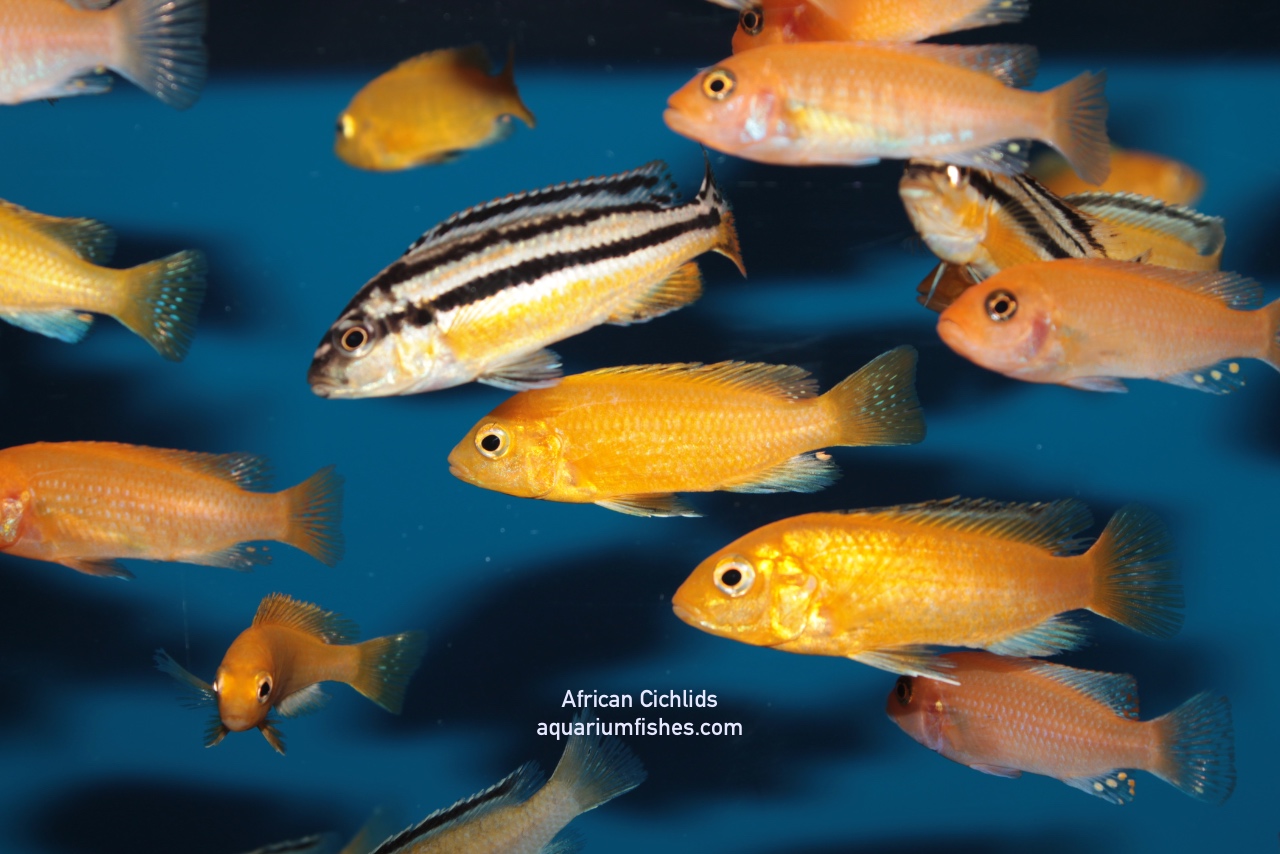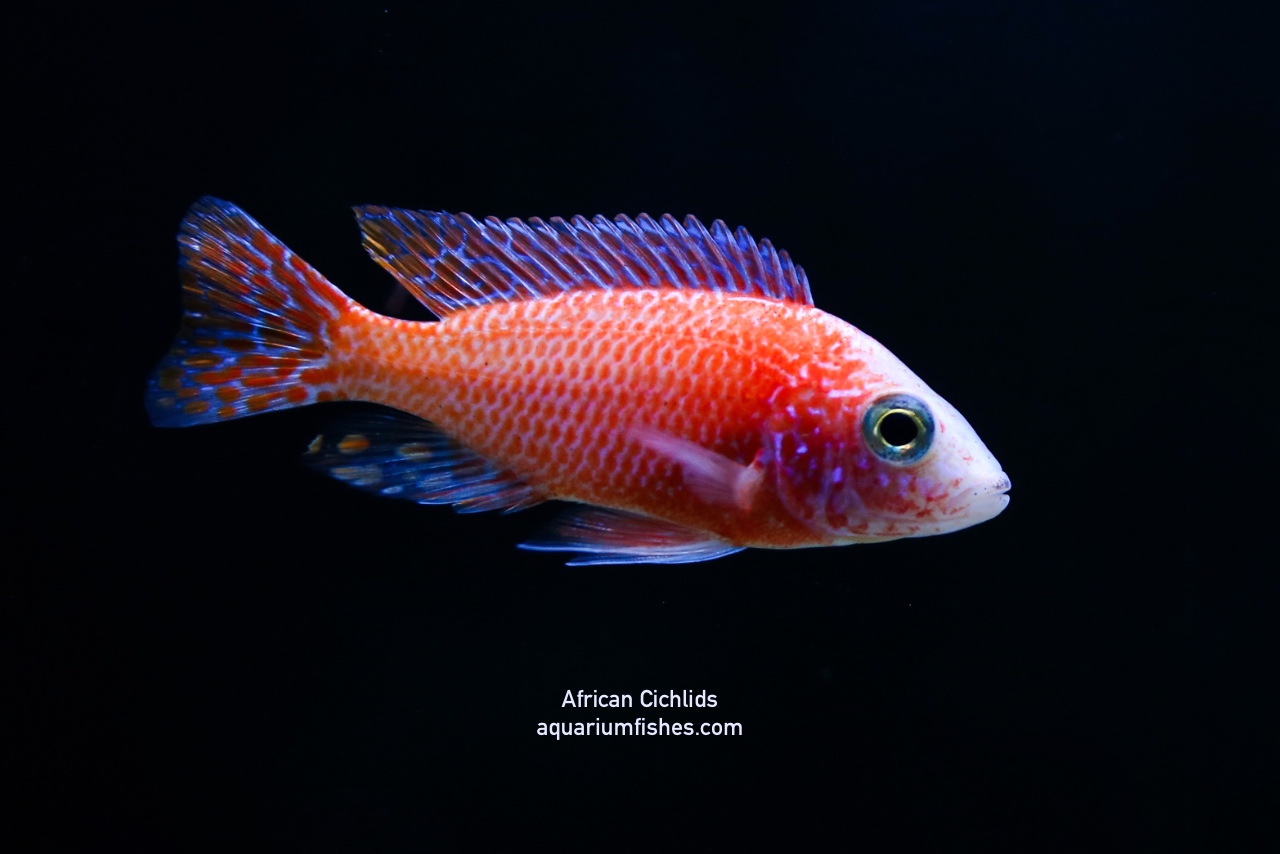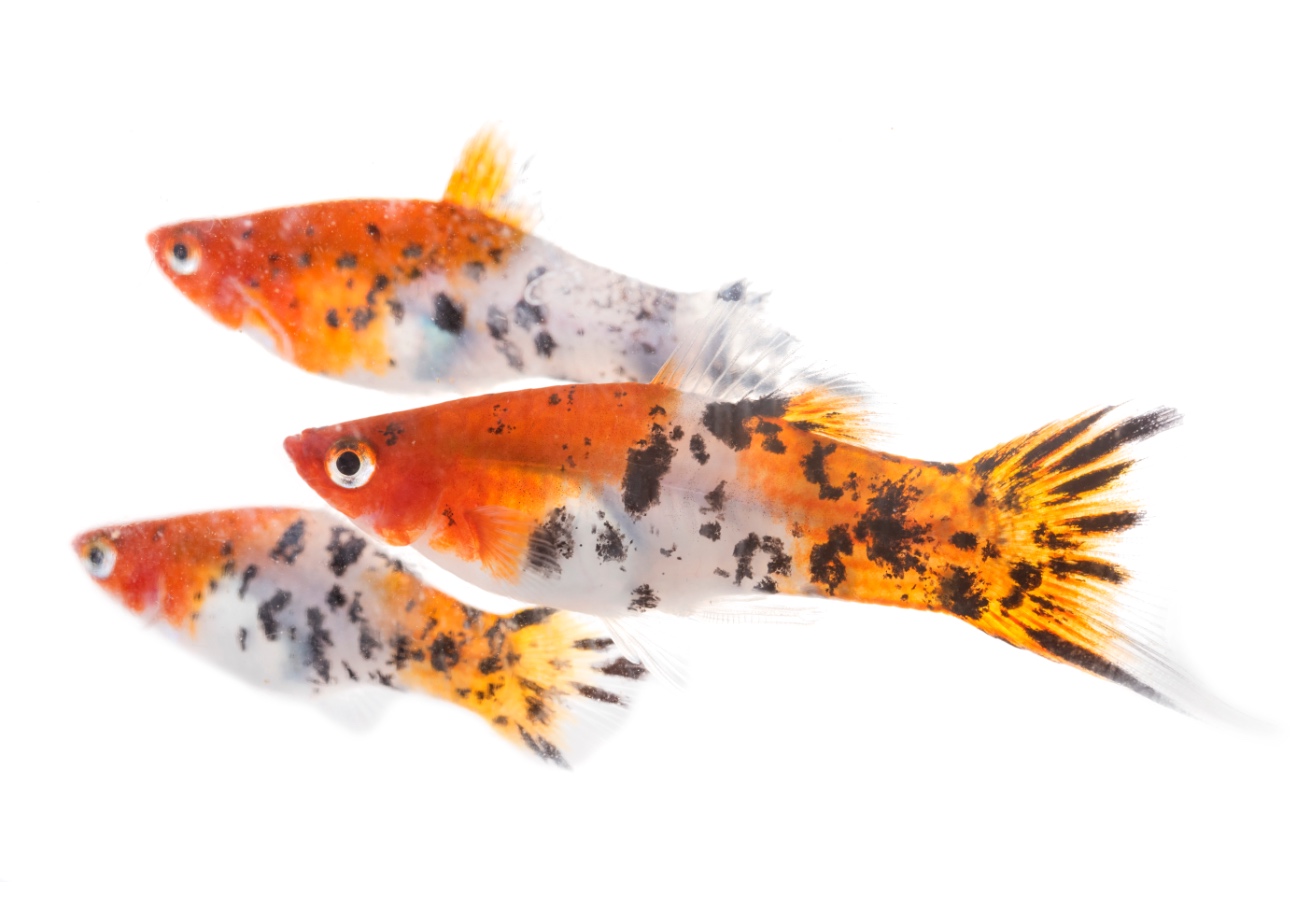African Cichlids are famous tropical fish. They are found in diverse colors and patterns, and their colorful appearances will make your aquarium look alive.
However, only expert aquarists can maintain these beautiful fish. They are bigger and more aggressive than other fish like Guppy, Tetra, and Gourami, so beginner aquarists should start with only one fish.
Peacock Cichlids are the most popular variety. In our guide, we will discuss everything from their appearance to care in your aquarium.
| Category | Rating |
|---|---|
| Family | Cichlidae |
| Temperament | Aggressive |
| Lifespan | Up to 15 Years (species dependent) |
| Care Level | Intermediate |
| Size | 3-8 inches |
| Color Form | Various |
| Diet | Depends on species |
| Compatibility | Depends on species |
| Minimum Tank Size | 30 Gallons |
| Tank Set-Up | Freshwater: Rocks and Caves |
African Cichlids Overview
Cichlid family has a wide variety of fishes, and they are found in diverse colors and patterns. Most species are found mainly in the three lakes: Lake Malawi, Lake Victoria, and Lake Tanganyika. Lake Malawi is the most famous one.
There are approximately 1500 species that belong to this family. Each one of them having a unique and beautiful appearance. Their vivid appearance is the reason for their popularity.
These colorful fish are quite active, hardy, and social. However, they can also become aggressive when mating, making finding a suitable companion challenging.
Their price range depends on their appearance.
The bigger and brighter-colored fish will be more expensive than normal fish. The cheapest Cichlids are available in the range of $5-$15. The price also depends on their age and health, as juvenile Cichlids are less expensive than adults.
How long do African cichlids live?
African cichlids may live up to eight years in your aquarium. Their lifespan depends upon your care and may differ from species to species.
Typical Behavior
African Cichlids are intelligent, interactive, and active swimmers. As soon as they sense a movement, they follow it, hoping to get fed. They can happily eat the whole day, but it can lead to overeating and make them sick.
Their activity and interaction make them more attractive and liven up the aquarium.
Apart from these qualities, you should look out for their aggression. They can get aggressive during mating season and can kill other fish over it. So, make sure there are as many hiding places for each of them.
Their active lifestyle includes pulling off the decorations or digging through the substrate to find food or hunt. They can also jump out of the tank excitedly, so make sure everything is well-covered and protected.
Many of their species show unique behaviors, including playing dead until a prey crosses them.
African Cichlid Types
As we have already learned, African Cichlids have a diverse variety; here, we will learn about the popular and most common types of them.

Yellow African (Labidochromis Caeruleus)
This little yellow African Cichlid is easy to look after and less aggressive than the others in its family. It is found in Lake Malawi. It can grow up to only 3 inches and is easy to find a companion for.
They have a yellow body with fins and black tips, making their appearance stand out from that of the other fish. Their dorsal fins are found behind their head and span all over their body. Their bright yellow color makes it look like they will produce electricity.
African Butterfly (Anomalochromis Thomasi)
Butterfly Cichlids are also very peaceful and hardy. These small fishes can grow up to 3 inches and are easy to breed. They are usually found in Liberia, Guinea, and Sierra Rivers.
Their whole body has five black vertical bars with horizontal rows of spots, either blue or green. This adds more beauty to their appearance. They are not very demanding or fussy and, hence, make perfect fish for beginners.
Orange Zebra Cichlid (Maylandia Estherae)
These fish can grow up to 5 inches but are not ideal for a small aquarium.
They are known for aggression, and limited swimming space will only fuel the aggressive behavior in them. So, beginners shouldn’t have them or start their aquariums with them.
These bright orange fishes are found in Lake Malawi. They have a round head and sometimes can have black tips on fins, just like the yellow Cichlids.
African Peacock (Aulonocara Nyassae)
From the name peacock, it is obvious that they are colorful, just like a peacock’s tail. This breed alone has 22 different species, all of which can be found in Lake Malawi.
Just like the peacock bird, only the male Peacock Cichlid has a vivid appearance, while the female is drab in appearance.
Their maximum size can reach up to 4 to 6 inches, and they will add variety and vividness to your aquarium. However, some of their species can be aggressive.
General Appearance and Color Varieties
As we already know, they have a vivid appearance, and each species has its unique quality. If you are raising a fry, then you have to be a little patient to see their color and pattern. It depends from species to species and can sometimes vary between individuals of the same species as well. It usually takes a year to show color.
The female Cichlid doesn’t look as attractive as the male ones. They usually have a dull appearance and pattern.
The brightness of color and pattern of Cichlids say a lot about them. Their colors are brightest when they show dominance or aggression and also at the time of mating. The brightness also depends on their diet. So, if you see the color fading, it can be a signal of poor health.
Cichlid also has a set of teeth. It also varies from species to species and depends on their diet. Their teeth have been subject to study by scientists, especially in dentistry. Some of them have evolved teeth to scrape off algae from rocks, while some have fang-like to hunt small fishes. Some species can even bite you.
Their damaged or lost teeth are replaced every 100 days, which makes Cichlids more fascinating.
African Cichlids Size
A mature African cichlid may grow up to 4 to 6 inches.
African Cichlid Habitat and Tank Conditions

To make the conditions hospitable for the fish, you must copy their native environment. The Cichlids are usually found to be living in the gaps between the rocks in their native place.
To set up an aquarium for Cichlids, you have to create many hideout places for them. You can use caves and even rocks for this. Make sure the rocks are properly glued together, and use safe aquarium glue to avoid any mishappening.
| Conditions | Parameters |
|---|---|
| Water Temperature | 75-85°F |
| Water pH | 7.8-8.6 |
| Water Hardness | 4-6 dH |
| Plants | Java fern, Anubias and Amazon Swords |
| Substrate | fine-grained |
| Lightning | Moderate |
| Nature of Water | moving |
You only need filter and heater in equipment to make the conditions stable and hospitable for them. These filters will be enough to keep water moving and create small currents. You can use the air pump to create a strong current.
The heater should be enough for the size of your tank. Don’t use under gravel filter as fine gravels are not suitable for them. Also, make sure the filter can process water 3-5 times an hour.
African Cichlid Tank Size
What size tank do cichlids need?
The tank size for African Cichlids varies from species to species. A smaller Cichlid, like an electric yellow Cichlid, needs a minimum of 30 gallons tank. If you want to add more yellow Cichlids, 3 gallons will be required for each fish.
In contrast, larger ones, like blue Cichlids, need a 50-gallon tank. They are active swimmers, and if they don’t have ample space, they can become more aggressive. Always remember to research your species and their needs before deciding the tank size.
African Cichlid Tank Mates
If you are keeping Cichlids for the first time, I suggest you start with one. They are aggressive and can harm or kill other fish of the same species if threatened.
If you want to keep them with others, then make sure they share the same size and temperament. Otherwise, your Cichlid will attack the smaller or more peaceful fish and turn them into a meal.
African catfish are perfect for them as they are bottom dwellers and fast swimmers. They can defend themselves.
If you want to keep more than one Cichlid, make enough hiding places or caves for them to claim their territory. Also, the tank should be large enough for them to swim without crossing each other’s territory.
While mixing different species of Cichlids, don’t put African and South American Cichlids together. They are raised in different water conditions, and their immune systems differ. They can make each other sick.
African Cichlid Diet and Food
African Cichlids can have different diets. It usually depends on their species. Some of them are herbivores like Tilapia, while some are insectivores like Peacock Cichlids. Some feed only on small fish, such as Butterfly Cichlids. In contrast, some can mix two or all three diets. Like Yellow Cichlids, they feed on meat and plants.
Research the species of your fish before feeding them anything. In your aquarium, you can also feed them with flakes as supplements. Apart from that, you can also add bloodworms, wafers, or live food.
For a herbivore fish, you can feed them raw fruits and vegetables. You can also give algae pellets or wafers to the bottom dwellers.
African Cichlid Care

To keep your Cichlids healthy, you should know about their diseases. Always look out for the symptoms. It will help in early diagnosis and cure. Let us take a look at the commonly found diseases in fish.
| Disease | Symptoms | Cause |
|---|---|---|
| Gill Flukes | Breathing difficulties | Flatworm parasite – slime-covered around the gills |
| Malawi Bloat | Abdomen swelling – kidney or liver problems | |
| Cotton Wool Disease | White growths | Fungus – due to poor water conditions |
| Hexamita | Loss of appetite and lesions | Parasite and poor water quality |
| Swim Bladder Disease | Difficulty to stay submerged | Physical injury or poor nutrition |
| Tuberculosis | White blotches and a loss of appetite | |
| White Spot (Ich) | White spots | Parasite |
Precaution
- Clean the tank
- Change the water every 1-2 weeks
- Check toxin level and try to reduce the nitrate level
- Don’t put Cichlids from a different origin in the same tank, as they have different immunity
Now, you know how to take care of African cichlids.
Breeding African Cichlids
African Cichlids can be bred in captivity if the conditions are suitable. They also perform cross-breeding, as in captivity, there are fewer males of the same breed. In the breeding season, make sure the tank’s water parameters are consistent.
To encourage breeding, avoid adding any new fish to the tank. Male African Cichlids show different moves to attract female Cichlids, and their colors are usually brighter at this time.
All the Cichlids lay eggs. They lay eggs in the safety of a cave and guard it, or some of them are mouthbrooders. They carry them in their mouth until it’s time to hatch. It takes around three weeks.
You can separate the eggs from the main tank, as the parents or other Cichlids can eat them. Once the eggs are hatched, the mother fish takes care of the fries for one or two weeks. After that, she leaves and is ready to breed again.
The color of the fry is fully visible within three months, and they will be ready to breed in a year. However, both of these qualities depend from species to species.
Should You Keep African Cichlids?
African Cichlids are not for the aquarium that has peace-loving, small-sized fish. They are aggressive and can hunt small fish for food.
Only the experienced aquarist should keep them. They are beautiful and active, and they will keep you entertained and add vividness to your aquarium. Once you keep them, you will know why they are so popular among aquarists.
Are you planning to keep African Cichlids for your aquarium? What are the qualities that you loved most about them? Let us know in the comment section below.



